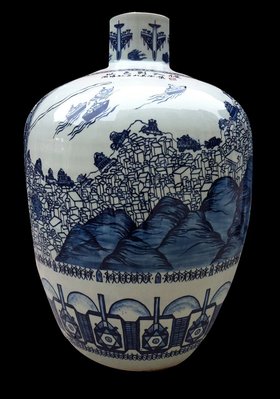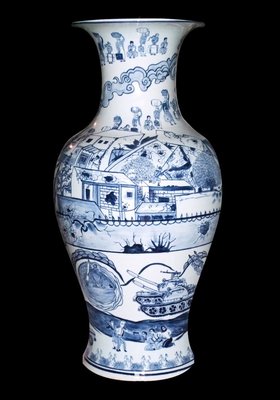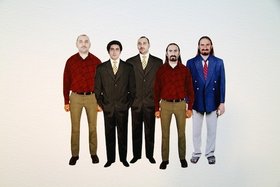Interviews
Disposable Memories
Raed Yassin in conversation with Nat Muller
Lebanese artist and musician Raed Yassin’s work mines recent history and pop culture for hypnotic and frequently amusing works that range from video to performance to sound art. Sampling sounds and images from obscure Arabic records, Egyptian films, and cable television, Yassin creates visual and aural collages underpinned by forms of visual interrogation and iconoclasm that are both personal and political. These include the murder of the artist’s father in Beirut in the 1980s, which provides a starting-point for his 2011 video and installation work Who Killed the King of Disco, in which Yassin imagines his father not dying but leaving Beirut to become an Egyptian screen idol. Or the reign of Hosni Mubarak in the 2008 video The New Film, which splices together scenes from Egyptian films in which Mubarak’s portrait is ever-present.
Ruminating on the collective imagination and aspirations of a region stretching from Morocco to the Gulf, Yassin explores memory through disposable culture, be it in the form of film and music, or the cheap commodities that are widely available across the region, if not necessarily produced there. As one of the recipients of the 2012 Abraaj Capital Art Prize, Yassin is presenting his new project China (2012) – depictions of Lebanese Civil War battles on decorative Chinese vases – as part of Abaaj’s exhibition during Art Dubai. He discusses this new work here with Nat Muller, curator of this year’s prize.
Nat Muller: So, Raed, a lot of artists from Lebanon, from the post-war generation, work a lot around issues of representation and collective memory. But you focus on popular culture in your work – why is that?
Raed Yassin: It’s maybe very simple: I really like it; I am addicted to commercial films, pop films, pop music. But also this has a connection with collective memory. My work with popular culture has a focus on manipulating collective memory and also the unconscious in the whole Arab world, because we in the Arab world share a lot of cinema and music in common. So if you play with this and you work mostly around this issue – which is manipulating pop culture – you can see the development of certain images and sounds through the consumer culture and this is something we have in common in the whole Arab world. So I feel connected to a whole generation that goes from Morocco to the Gulf.
NM: In your music and performance, you work with popular culture but your artistic work makes a lot of use of the image. The aesthetics in popular culture is a non-aesthetics but let’s say you ‘re-aestheticize’ it as well in a certain sense for your art practice.
RY: About this issue of the aesthetic and re-aesthetic – it’s a question but it’s also a concern for me. Why, I ask myself always, does my artwork or music or whatever, have to have a certain standard? Why it does it have to fit in the ‘white cube’? Why does it always have to be presented in the way that it should be presented? What I’m really interested in are people who mix images and make music in popular culture – they go much further than artists, because artists are really conservative. Whereas the former don’t have boundaries, they’re freer than the artists themselves. They’re more honest, even. I still feel that they are more honest than me. But maybe it’s not my job to be honest.
NM: But is it also a question of dissemination?
RY: Yes, it can be. But for me, I am really interested in this question of: how far you can go? Because pop cultural producers, they don’t have any standards for aesthetics or whatever it is, and the results are totally free.
NM: Do you see that there is a problem of historical narrative in the Arab world?
RY: I think it’s everywhere, not only in the Arab world.
NM: Does it manifest itself differently?
RY: Well, maybe in the Arab world because there is never a confrontation with history itself. Maybe now we can start to see something different after all these revolutions that are happening in the Arab world but I’m still sceptical about it. In the Arab world, ever since we got independence from the colonial powers, there was never any questioning about things related to identity, nationalism, religion, all of these main issues – we never confronted them. We took it for granted. Of course, there were some movements but it was a problem of not having a clear historical narrative. It can also be personal. But at least let’s say that the standards for that are not even clear.
NM: Your recent commission for the Abraaj Capital Art Prize is China – perhaps you can talk about it a bit, how it speaks to this issue of history and the non-closure of historical events and their interpretation?
RY: With a very sensitive issue like the Lebanese Civil War, which everybody has been using for so long, I wanted to do a project related to it but that wasn’t just about the Civil War – I wanted to do a project about the Civil War that really makes it more like a decorative item. After doing a lot of interviews and research and seeing how people talk about these traumatic experiences of being in a battle – what does it mean, how do you visualize that? – I went to China, after making some designs in Lebanon, and gave the designs to Chinese masters so they could draw these Civil War battles on porcelain vases. And of course, I worked with different masters, so some of them look to different dynasties. But I also want to just keep my work a little bit removed from it. By putting it on decorative items, I get rid of it, in a way – it becomes like a vase, for the house. I want to have this vase in every house, so everybody could just get rid of it. I just want to get rid of the issue, make it more like a decorative, throw-away item.
NM: But is it because it’s in the house and is such a domestic, decorative object – is it a way of controlling it somehow?
RY: I didn’t think of it in that way – it’s more for me to have a projection of something historical, which is historical in Lebanon but also has a connection with the Ancient Greeks, who used to document these moments from battles on vases. The Ottomans did it, the Persians did it, and also the Chinese did it. I chose China as the place to do this stuff, that was my main idea – it wasn’t about controlling the issue, more like getting rid of the issue and as I said, making it a decorative item.
NM: The whole idea was that it’s made in China, it’s mass-produced – how does that fit into the project, these issues of globalization and mass production?
RY: I am interested in this area of mass production, how mass production can change the way people consume and the way people look at things. Because of mass production, we have popular, trash culture. Mass production really helps people consume more and more and make stuff more quickly and as a result there are mistakes and misunderstandings. Actually, it’s making things more interesting. But with this project, I chose China because everything is produced there. Now, everything we use is produced in China, it’s the place you produce everything for the whole world, so why not reproduce my Lebanese Civil War there too? And then it will be like a mass-produced item that everybody could have in their homes and then maybe we could come to a point where we are fine with the issue.
NM: You have seven vases, which depict seven seminal battles in the Civil War. Can you explain the process of how you chose the battles and how you chose to depict them? Do you work from source materials or texts – how do you represent these events?
RY: In the Lebanese Civil War, there were so many battles, there was one going on almost every day. There is something specific that all these battles have in common, which is that they all changed the demographic of the Civil War. Most of the battles didn’t but these ones made a demographic change, where a whole sect just moved to another place, or some people were erased or whatever. It’s all based on stories from inside the battles, fighters and people who lived it.
NM: So you did interviews with people?
RY: Interviews with people, I researched documents, newspapers, you know, someone said this or that in a newspaper. And it’s not easy to make people talk, especially about this, even to access archives because everyone wants to know what you want to do with it. So I have to go through the whole rigmarole of, are you really doing an art project about vases and all this? And of course, I went through photographic archives from newspapers. So that was the process, first collecting all my materials and then starting to work out a logic about how to make the scene and then make the composition and then work out a design for the scene and when that was all ready, take it to China.
NM: But the aesthetics, the way that the figures in these historical scenes are drawn, does that reference a particular period in history where there was a lot of historical commemoration on vases, do you reference that?
RY: Actually, I chose a style that was closer to Islamic miniatures because I wanted to work with figures that were reminiscent of Arabic and Islamic ways of depicting battles. In miniatures, you see a lot of depictions of battles, hunting trips. So I began to develop a style that was closer to Islamic miniatures, but then gave it to a Chinese painter who is making his own interpretation of it.
NM: And did that differ much from the original drawing?
RY: Sometimes yes, sometimes no – sometimes, it was a bit different.
NM: And it was really deliberate to keep those different interpretations as well, so it was a build-up?
RY: Yes, of course, I really wanted these painters to have different styles, their own touch.
NM: Let’s go back to these historical vases, where these battles are depicted – is there then a certain chronology you can see? Your vases are circular, there’s no end to the history.
RY: That was one of the ideas also, just to have something totally rounded where there is no start and end point; the action is going on and on all the time. You can look at it, and it’s always in place.
NM: I’m also interested in how the sensibility or the value of the object shifts on the one hand from decorative, to on the other hand, historical, maybe at times even commemorative and monumental but also mass-produced and replaceable somehow – does it really shift or is it all one?
RY: It doesn’t really shift; there are all these layers that exist in the work. There is another background, which is related to the object itself. You can read all these layers on a Chinese vase which you can see almost everywhere.
NM: Also in Lebanese homes?
RY: Yes, everywhere. From afar you just see a Chinese vase but if you get close to it, you see there are all these different designs on it. Your first impression is: this is just a Chinese vase; you see more when you get closer to it.
NM: Last year at the Sharjah Biennial, you had an interesting project with the collective Atfal Ahdath – that’s you, Vartan Avakian and Hatem Imam – also very much using popular culture and studio photography. It’s so particular to the region, I’m just interested in how it was received and also, is it at all a project that you can transport abroad, out of the Arab world?
RY: Actually, it can be difficult to transport within the Arab world itself because it references a very particular type of studio practice.
NM: Maybe you can explain the project?
RY: It’s a project called Take me to this place: I want to do the memories (2010-11) and this Atfal Ahdath art collective, which consists of the guys you mentioned and myself, works on a lot of different stuff but for this particular project we were interested in studio photography practice now and what does it mean, really? That’s studio photography practices in the developing world, actually, not only in the Arab world. So we went to popular studios and saw how they took photos of people.
NM: This is in Lebanon and Syria?
RY: Syria, Egypt, the Pakistani studios, for example, in Sharjah and Dubai. And you can see what everybody wishes for themselves. Because now in photography studios, instead of having backgrounds, they have Photoshop, you have a blue screen and you can replace it with any backdrop you want. People from working class backgrounds, they really couldn’t live those memories, they cannot take photos in New York or Paris, so they actually go to the photography studios and they take photos in front of that blue screen and replace it with images of a castle or the Eiffel Tower, or some other nice landscape, and later they can look at these photos. This of course raises so many questions about society and the aspirations of the people. Sometimes, it doesn’t translate within the Arab world, because not everybody in the Arab world is from this working society, but this particular society – because of the economy – produced an aesthetic need. They made it very fast, really Photoshopped and pixellated, but it’s also as if there are dreams and aspirations behind it all.
NM: The memory becomes a wishful thinking?
RY: Yes, exactly. It’s inverted – you make it yourself, it’s something that you wish, a memory that you live, only it’s not. Of course, there are so many layers where you can change the background, be anywhere else, but you can also change your body and be someone else. If you go there and you don’t have enough money for a suit, they have a ready-made suit for you, but it also extends to whether you want to be a thin guy or a muscular guy, it depends. And for people who can’t afford big weddings, especially in poorer areas, they have a load of dresses ready in Photoshop to make a whole wedding situation happen. And you can do this and keep the memory – even if you didn’t live it.
Raed Yassin was born in Beirut in 1979 and graduated from the Theatre Department at the Lebanese University in Beirut. He is a musician and artist, has exhibited his works across the Arab world and in Europe, and is represented by Kalfayan Galleries in Greece. He also runs the independent record label Annihaya in addition to organizing the free-improvization music festival Irtijal in Lebanon. Yassin is a recipient of the 2012 Abraaj Capital Art Prize.








